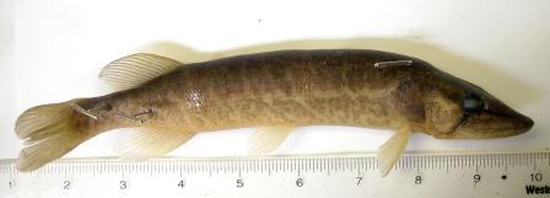| Esocidae (Pikes) |
| 39.4 cm FL (male/unsexed); max.weight: 1,020.0 g |
|
demersal; freshwater; brackish; pH range: 10.1499996185303, non-migratory |
| North America: Atlantic Slope drainages from St. Lawrence River drainage in Quebec, Canada to southern Florida, USA; Gulf Slope drainages east to Brazos River, Texas, USA; Mississippi River and Great Lakes basins north to Nebraska, Wisconsin, Mississippi in USA and southern Ontario in Canada. Two subspecies were previously recognized: Esox americanus americanus in Atlantic Slope drainages to southern Georgia; and Esox americanus vermiculatus in rest of range. |
|
Dorsal spines (total): 0-0; Dorsal soft rays (total): 13-21; Anal spines: 0-0; Anal soft rays: 13-18; Vertebrae: 42-51. Body robust, long, cylindrical, cross-section almost circular with flattened to slightly concave dorsal surface. Head large, flat, naked on top. Snout short, broad spatulate, dorsal surface between raised orbits and tip of snout slightly convex. Mouth large, horizontal, reaching at least to middle of pupil or suborbital bar. Teeth moderately large, those in front of upper jaw and several along each side of ramus a little enlarged; cheek and opercle fully scaled. Gill rakers are reduced to patches of sharp denticles. Branchiostegal rays: 19-31. Cardioid scales between pelvic fins 6-32, intergrades 0-26; notched scales in a line between dorsal and anal fin origins 7-25, intergrades 1-22. Submandibular pores 3:2 to 6:5, usually 4:4.
Pigmentation: Olivaceous to black above; belly pale amber to white, sometimes mottled wit dark; mid-dorsal band from nape to dorsal fin origin inconspicuous and pale. Sides with 20-36 olive to black wavy vertical bars separated by paler extensions of what had been lateral band in young, pale area between adjacent bars narrower. Suborbital and preorbital black bars pronounced, suborbital curved back ventrally, postorbital horizontal; lateral edges of jaws heavily pigmented. Pupil yellow to yellow green, iris gold. Dorsal fin darkly pigmented, others orange to red. |
| Live in lakes, swamps, and backwaters, and sluggish pools of streams. Usually occur among vegetation in clear water (Ref. 86798). Also found in brush piles, overhanging brush or rocks and boulders in areas lacking vegetation. Rarely occur in rivers (Ref. 4639). In winter, they are found associated with dead leaf litter (Ref. 39089). Juveniles are found in flood pools and rivulets among exposed roots, twigs, leaves, and grass in 7.6-10.2 cm of water (Ref. 39088). Larvae are sometimes found in very shallow water in roadside ditches, also in dead leaf litter (Ref. 39089). Oviparous (Ref. 205). |
|
Least Concern (LC); Date assessed: 01 December 2011 Ref. (130435)
|
| harmless |
Source and more info: www.fishbase.org. For personal, classroom, and other internal use only. Not for publication.
